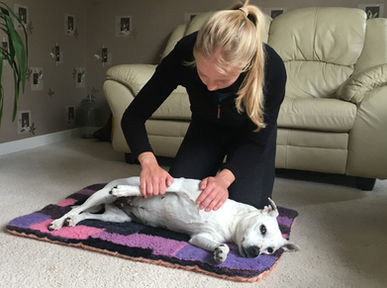top of page
Manual Therapy
Massage
Massage therapy is an ancient modality that has a variety of beneficial effects, both physical and psychological. Simply put, massage provides an input of energy into the tissues and provides a change in pressure which stimulates many cellular effects.
Some of the global effects of massage include: increasing circulation, improving lymphatic drainage, promoting muscle relaxation, reducing stress, improving posture, removing inflammatory products from damaged tissues, providing pain relief, reducing scar tissue, increasing muscle extensibility and increasing joint range of motion. All of the above help to improve physical well being, improve performance and most importantly, reduce risk of injury.
Indications:
-
Chronic musculoskeletal problems
-
Trigger points
-
Oedema
-
Muscular hypertonicity
-
Muscular atrophy
-
Muscular pain
-
Scar tissue
-
Fatigue
-
Warm-up
A variety of massage techniques will be used within a veterinary physiotherapy session, all with slightly different effects on the body. Each different technique is adapted to every individual, based on how they react to each type of massage. The massage techniques that Stacie uses in a veterinary physiotherapy session include; effleurage, skin rolling, wringing, squeezing, compression, tapotement, friction, trigger point therapy and sensory massage.
Massage may also be an exercise that an owner can do between visits, but make sure your veterinary physiotherapist has both demonstrated and assessed your ability to perform the massage technique.
Myofascial Release


Myofascial release is a manual therapy technique using gentle sustained pressure up to 120 seconds on the myofascial connective tissue. It has a huge effect on the fascia of the body, which in turn impacts on muscles, tendons and ligaments. Fascia is a web-like system that surrounds and connects every structure in the body; it is completely connected from the head to the tail.
Fascia can become dehydrated and since it acts as a single system, one restricted area of fascia can impact the body in another completely different place, consequently impacting on movement and performance.
Myofascial release helps to lengthen fascia, break down fascial adhesions, allow tissues to glide over eachother, re-establish the normal electrical charge of cells, and promote improved circulation. Horses will show signs of of release by licking, chewing, yawning and relaxing.
Causes of fascial restriction:
-
Trauma
-
Inflammation
-
Conformation issues
-
Overuse
-
Poor saddle fit
-
Foot imbalances
-
Rider imbalance

Stretching
Stretching is often used within a session following massage, once the tissues are warmed up, to enhance the effects of massage and promote muscular relaxation. It is also commonly an exercise that is left with owners to perform between visits if deemed appropriate by your veterinary physiotherapist. Stretching can be performed on the limbs, spine and neck.
Stretching has many beneficial effects, including: improving circulation, improving joint range of motion, reducing the effects of delayed onset of muscle soreness (DOMS), decreasing muscular adhesions, promoting efficient scar tissue formation, decreasing hypertonic muscles, promoting pain relief, improving proprioception and increasing overall flexibility.
There are many contributing factors that result in adaptive shortening of muscle fibres. Movement abnormalities, compensatory issues and repetitive strain can cause the muscle fibres to shorten and become contracted. Left in this contracted state, excess strain is placed upon tendons and ligaments, ultimately increasing the risk of injury and reducing performance.
Indications:
-
Immobilisation
-
Reduced mobility
-
Injury
-
Post-surgery
-
Fibrosis of periarticular tissues
-
Scar tissue
-
Chronic muscle contracture
Stretching should only ever be performed on warm muscles following exercise, massage or application of a heat pack. Please ensure that you only stretch your horse or dog following a veterinary physiotherapists advice and demonstration, as each animals' ability to perform a certain stretch will depend on a number of factors.
bottom of page


































